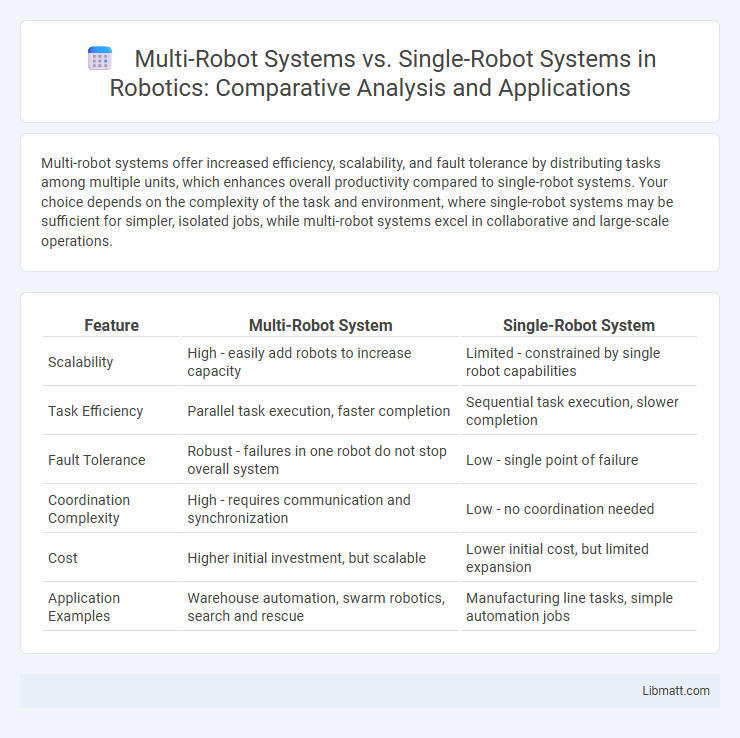Multi-robot systems offer increased efficiency, scalability, and fault tolerance by distributing tasks among multiple units, which enhances overall productivity compared to single-robot systems. Your choice depends on the complexity of the task and environment, where single-robot systems may be sufficient for simpler, isolated jobs, while multi-robot systems excel in collaborative and large-scale operations.
Table of Comparison
| Feature | Multi-Robot System | Single-Robot System |
|---|---|---|
| Scalability | High - easily add robots to increase capacity | Limited - constrained by single robot capabilities |
| Task Efficiency | Parallel task execution, faster completion | Sequential task execution, slower completion |
| Fault Tolerance | Robust - failures in one robot do not stop overall system | Low - single point of failure |
| Coordination Complexity | High - requires communication and synchronization | Low - no coordination needed |
| Cost | Higher initial investment, but scalable | Lower initial cost, but limited expansion |
| Application Examples | Warehouse automation, swarm robotics, search and rescue | Manufacturing line tasks, simple automation jobs |
Introduction to Multi-Robot and Single-Robot Systems
Multi-robot systems consist of multiple autonomous robots capable of coordinating tasks and sharing information to improve efficiency and resilience. Single-robot systems operate independently, performing tasks without collaboration, often resulting in simpler control but limited scalability. Multi-robot systems excel in complex environments through distributed problem solving, while single-robot systems are preferred for straightforward, isolated tasks.
Core Differences Between Multi-Robot and Single-Robot Architectures
Multi-robot systems consist of multiple autonomous robots collaborating to complete tasks, offering scalability, redundancy, and enhanced efficiency compared to single-robot systems, which rely on a lone robot for operation. Communication, coordination, and distributed control architectures are essential components distinguishing multi-robot frameworks, whereas single-robot systems emphasize centralized control and simpler navigation algorithms. Your choice between these architectures depends on application complexity, task distribution, and desired fault tolerance.
Scalability: Multi vs. Single-Robot Systems
Multi-robot systems offer superior scalability by enabling tasks to be distributed across numerous units, thereby increasing efficiency and coverage compared to single-robot systems. Single-robot systems face inherent limitations in workload and area coverage, which can hinder performance as task complexity grows. Your operations can benefit significantly from multi-robot systems when scalability and adaptability to dynamic environments are essential.
Task Distribution and Coordination Strategies
Multi-robot systems leverage decentralized task distribution and coordination strategies such as market-based algorithms, behavior-based control, and consensus protocols to enable efficient parallel task execution and dynamic adaptability. Single-robot systems rely on centralized control and predefined task sequences, limiting flexibility and scalability in complex environments. Coordinated multi-robot systems optimize resource allocation and reduce redundancy by enabling communication and collaboration among robots, enhancing overall mission performance.
Reliability and Redundancy in Robotic Systems
Multi-robot systems offer enhanced reliability and redundancy compared to single-robot systems by distributing tasks across multiple units, ensuring that the failure of one robot does not compromise the entire operation. These systems enable continuous functionality through collaborative problem-solving and dynamic reallocation of resources, increasing overall mission success rates. Your robotic applications benefit from increased uptime and fault tolerance when leveraging multi-robot architectures.
Cost Analysis: Investment and Maintenance
Multi-robot systems require higher initial investment due to the cost of multiple robotics units, complex integration, and advanced coordination software, while single-robot systems demand lower upfront expenditure on individual hardware and simpler setup. Maintenance costs in multi-robot systems increase with the number of robots, including routine servicing, repairs, and software updates, whereas single-robot systems incur comparatively lower maintenance expenses. Efficient allocation of tasks in multi-robot systems can reduce operational costs over time despite the higher investment.
Communication Challenges and Solutions
Multi-robot systems face significant communication challenges such as signal interference, bandwidth limitations, and latency issues, which can disrupt coordination and data sharing. Solutions include implementing decentralized communication protocols, adaptive frequency hopping, and robust error-correction algorithms to ensure reliable information exchange. In contrast, single-robot systems experience fewer communication complexities, relying primarily on internal sensors and processors without the need for inter-robot networking.
Flexibility and Adaptability in Dynamic Environments
Multi-robot systems offer superior flexibility and adaptability in dynamic environments by enabling coordinated task distribution and real-time communication among robots. Unlike single-robot systems, they can quickly reconfigure roles and paths to respond to unexpected obstacles or changes, enhancing operational efficiency. Your projects can benefit from increased resilience and scalability through the deployment of multi-robot systems in unpredictable settings.
Application Domains: When to Use Multi or Single-Robot Systems
Multi-robot systems excel in complex applications requiring parallel task execution, such as warehouse automation, search and rescue operations, and large-scale environmental monitoring, where coordination and scalability are critical. Single-robot systems are preferred in environments with limited space, simpler tasks, or where human-robot interaction is intensive, such as surgical robotics and precision manufacturing. Decision-making depends on task complexity, required redundancy, and operational environment constraints, driving the choice between multi-robot collaboration and single-robot efficiency.
Future Trends and Technological Advancements
Multi-robot systems are rapidly evolving with advancements in autonomous coordination, machine learning, and swarm intelligence, enabling greater scalability and robustness compared to single-robot systems. Emerging technologies such as 5G connectivity, edge computing, and AI-driven real-time decision-making are enhancing multi-robot collaboration efficiency and adaptability in dynamic environments. Future trends emphasize decentralized control architectures and enhanced human-robot interaction to optimize task distribution and resource utilization across robotic fleets.
Multi-robot system vs Single-robot system Infographic

 libmatt.com
libmatt.com